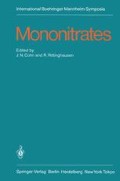Abstract
IS-5-MN, an active metabolite of isosorbide dinitrate (ISDN), has been used as a pharmacological compound in patients with stable angina pectoris during their usual activities or when submitted to stress tests, with excellent clinical results [1,2].
Access this chapter
Tax calculation will be finalised at checkout
Purchases are for personal use only
Preview
Unable to display preview. Download preview PDF.
References
Müller G, Schmidt Voigt J (1981) Die Wirkung von IS-5-MN bei koronarer Herzkrankheit. Med Welt 32:554
Müller G, Hacker W, Schneider B (1983) Intra-individual comparison of the action of equal doses of isosorbide-5-endomononitrate, slow-release isosorbide dinitrate and placebo in patients with coronary heart disease. Klin Wochenschr 61:409
Evans W, Heyle C (1953) Comparative value of drugs used in the continuous treatment of angina pectoris. Quart J Med 2:311
Aronow WS, Chesluk HM (1970) Sublingual isosorbide dinitrate therapy vs sublingual placebo in angina pectoris. Circulation 41:869
Goldstein RE, Reswig DR, Redwood DR, Beiser GD, Epstein SD (1971) Clinical and circulatory effects of isosorbide dinitrate. Circulation 43:629
Sociedad Argentina de Cardiologia (1981) Consejo de ergometria y rehabilitation. Recomenda-ciones para la práctica normalizada de ergometria. Buenos Aires
Ellestad MH, Allen W, Wan MCK, Kemp GL (1969) Maximal tradmill stress testing for cardiovascular evaluation. Circulation 39:517
Stoltz FJ, Rohac JM (1975) Reproducibility of exercise tests in patients with symptomatic ischemic heart disease. Br Heart J 37:785
Fucks RM, Erinker JA, Maugham WL, Weidfeldt MJ, Kin FC (1981) Coronary flow limitation during the development of ischemia. Effect of atrial pacing in patients with left anterior descendent coronary disease. Am J Cardiology 48:1029
De Servi S, Specchia G, Falcone C, Gravazzi A, Mussini A, Angioli L, Bramucci E, Ardissino D, Vaccari L, Salerno J, Bobba P (1983) Variable threshold exertional angina in patients with transient vasoespastic myocardial ischemia with respect to exercise test results and therapeutic implications. Am J Cardiology 51:397
Mehmel HC, Ruffmann K, Schwarz F, Manthey J, Kübier W (1981) Die Wirkung von Isosor-bid-5-Mononitrat (IS-5-MN) auf die linksventrikuläre Hämodynamik.
Biamino GM, Oeff D, Andresen HJ, Lichey E, Prokein R, Arntz, v. Leitner E, Schröder R (1981) Hämodynamische Effekte von Isosorbid-5-Mononitrat unter Ruhe- und Belastungsbedingungen bei Patienten mit schwerer Angina pectoris. Med Welt 32:535
Bödigheimer K, Nowak FG, Delius W (1981) Vergleichende invasive Untersuchung von Isosor-bid Mononitrat und Isosorbid Dinitrat. Med Welt 32:543
Sarnoff SJ, Braunwald E, Welch GH (1958) Hemodynamic determinants of oxygen Consumption of the heart, with special reference to the tension-time index. Am J Physiol 192:148
Grobel FL, Nordstrom LA, Nelson RR, Vorganse CR, Wang Y (1978) The rate pressure product as an index of myocardial oxygen consumption during exercise in patients with angina pectoris. Circulation 57:349
Robinson BF (1967) Relation of heart rate and systolic blood pressure to the onset of pain in angina pectoris. Circulation 35:1073
deAptecar F, Aptecar M, Vázquez A, Dell Arsiprete CF (1981) Respuesta Cardiovascular al Esfuerzo en el Hombre Sano. Estudio Sistemático de las Variables Fisiológicas. Rev Arg Cardiologia 49: Suppl 1
Tabakin BS, Hanson JS, Messiam TW, Candvell GJ (1964) Hemodynamic response of normal men to graded treadmill excercise. J Appl Physiol 19:457
Gregg DE, Fisher LC (1963) Blood supply to the heart. In: Hamilton WF, Dow P. Handbook of Physiology, Soc 2. Circulation. American Physiological Society, Washington
Wilmore JH (1977) Acute and chronic physiological responses to exercise in cardiovascular health and disease. Amsterdam EA, Wilmore J, De Maria H (eds) York Medical Books, New York
Ellestad MH, Allen W, Wan MCK, Kemp GI (1969) Maximal treadmill stress testing for cardiovascular evaluation. Circulation 39:517
Foster GL, Reeves J, Meade JH (1966) Hemodynamic responses to exercise in clinically normal middle age men and in those with angina pectoris. J Clin Invest 43:1758
Forman R, Eng C, Kirk ES (1983) Comparative effect of verapamil and nitroglycerin on collateral blood flow. Circulation 67:1204
Wagniart P, Ferguson RI, Chaitman BR, Achard F, Benacerraf A, Delanguenhagen B, Morin B, Pasternac A, Bourasa M (1982) Increased exercise tolerance and reduced electrocardiography ischemia with diltiazen in patients with stable angina pectoris. Circulation 66:23
Chaitman BR, Wagniart P, Pasternac A, Brevers G, Scholl JM, Lam J, Methe M, Ferguson RJ, Bourassa MG (1984) Improved exercise tolerance after propranolol, diltiazem or nifedipine in angina pectoris: comparison at 1, 3 and 8 hours and correlation with plasma drug concentration. Am J Cardiology 53:1
Detry JM, Bruce RA (1971) Effects of physical training on exertional ST segment depression in coronary heart disease. Circulation 44:390
Redwood DR, Rosing DR, Godstein RE, Beiser GD, Epstein SE (1977) Importance of the design of an exercise protocol in the evaluation of patients with angina pectoris. Circulation 43:618
Editor information
Editors and Affiliations
Rights and permissions
Copyright information
© 1985 Springer-Verlag Berlin Heidelberg
About this paper
Cite this paper
Bidoggia, H.J., Casar, J.E., Hirschon, A.J., Campo, A., Nordaby, R. (1985). Beneficial Effects of Isosorbide-5-Mononitrate on Exercise Performance in Patients with Chronic Stable Angina Pectoris. In: Cohn, J.N., Rittinghausen, R. (eds) Mononitrates. International Boehringer Mannheim Symposia. Springer, Berlin, Heidelberg. https://doi.org/10.1007/978-3-642-70234-1_24
Download citation
DOI: https://doi.org/10.1007/978-3-642-70234-1_24
Publisher Name: Springer, Berlin, Heidelberg
Print ISBN: 978-3-540-15107-4
Online ISBN: 978-3-642-70234-1
eBook Packages: Springer Book Archive

